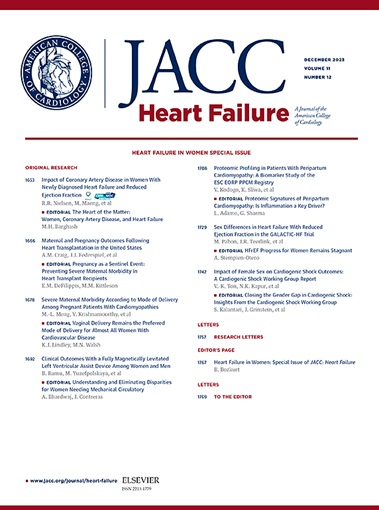Associations Between Urinary Metal Levels and Incident Heart Failure
IF 10.3
1区 医学
Q1 CARDIAC & CARDIOVASCULAR SYSTEMS
引用次数: 0
Abstract
Background
Environmental metals are recognized cardiovascular disease risk factors, yet the role of metal exposure in heart failure (HF) risk remains understudied.
Objectives
This study aims to evaluate the prospective association of urinary metals with incident HF across 3 geographically and ethnically/racially diverse cohorts: MESA (Multi-Ethnic Study of Atherosclerosis) and SHS (Strong Heart Study) in the United States, and the Hortega Study in Spain.
Methods
Adults 18-85 years of age in MESA (n = 6,601), SHS (n = 2,917), and Hortega (n = 1,300) were followed up to 20 years. Urinary levels of a multi-metal panel were measured at baseline and corrected for urine dilution. Cox proportional hazards and Cox elastic-net models were used to estimate the multi-adjusted (sociodemographic/clinical/lifestyle covariates) HR of incident HF by individual metals and the mixture of 5 metals available in all cohorts, respectively. The pooled HR (95% CI) of HF by 1-unit increase in log2-transformed levels of individual metals (ie, doubling of the dose) across cohorts was estimated using a fixed effects meta-analysis. Analyses by left ventricular ejection fraction were conducted in a subset.
Results
A total of 1,001 participants developed HF. In adjusted models, significant associations (pooled HRs [95% CI] per doubling of urinary metal) were identified for cadmium (HR: 1.15 [95% CI: 1.07-1.24]) molybdenum (HR: 1.13 [95% CI: 1.05-1.22]), and zinc (HR: 1.22 [95% CI: 1.14-1.32]). The HRs (95% CIs) for the association of 1 IQR increase in the multi-metal mixture levels and incident HF were 1.38 (95% CI: 1.00-1.86) in MESA, HR: 1.55 (95% CI: 1.28-1.97) in SHS, and HR: 1.08 (95% CI: 0.85-1.63) in Hortega in fully adjusted models. Stratified models by left ventricular ejection fraction were consistent with the pooled results.
Conclusions
Urinary metals are risk factors of HF across 3 diverse populations, supporting the role of reducing metal exposures to lower HF risk.
尿中金属含量与心力衰竭的关系
环境金属是公认的心血管疾病危险因素,但金属暴露在心力衰竭(HF)风险中的作用仍未得到充分研究。本研究旨在评估尿金属与HF事件的前瞻性关联,涉及3个不同地理和种族的队列:美国的MESA(多种族动脉粥样硬化研究)和SHS(强心脏研究),以及西班牙的Hortega研究。方法对MESA(6601例)、SHS(2917例)和Hortega(1300例)18-85岁成人进行随访,随访时间为20年。在基线时测量多金属板的尿液水平,并校正尿液稀释。Cox比例风险和Cox弹性网络模型分别用于估计所有队列中单个金属和5种金属混合物的多重调整(社会人口统计学/临床/生活方式协变量)心力衰竭事件的HR。使用固定效应荟萃分析估计各队列中单个金属的log2转化水平增加1个单位(即剂量加倍)导致HF的总HR (95% CI)。通过左心室射血分数对一个子集进行分析。结果共有1001名参与者发生HF。在调整后的模型中,确定了镉(风险比:1.15 [95% CI: 1.07-1.24])、钼(风险比:1.13 [95% CI: 1.05-1.22])和锌(风险比:1.22 [95% CI: 1.14-1.32])的显著相关性(每加倍尿金属的合并风险比[95% CI])。在全校正模型中,多金属混合物水平增加1 IQR与HF事件相关的HR (95% CI)在MESA中为1.38 (95% CI: 1.00-1.86),在SHS中为1.55 (95% CI: 1.28-1.97),在Hortega中为1.08 (95% CI: 0.85-1.63)。左室射血分数分层模型与合并结果一致。结论在3个不同人群中,膳食金属是HF的危险因素,支持减少金属暴露对降低HF风险的作用。
本文章由计算机程序翻译,如有差异,请以英文原文为准。
求助全文
约1分钟内获得全文
求助全文
来源期刊

JACC. Heart failure
CARDIAC & CARDIOVASCULAR SYSTEMS-
CiteScore
21.20
自引率
2.30%
发文量
164
期刊介绍:
JACC: Heart Failure publishes crucial findings on the pathophysiology, diagnosis, treatment, and care of heart failure patients. The goal is to enhance understanding through timely scientific communication on disease, clinical trials, outcomes, and therapeutic advances. The Journal fosters interdisciplinary connections with neuroscience, pulmonary medicine, nephrology, electrophysiology, and surgery related to heart failure. It also covers articles on pharmacogenetics, biomarkers, and metabolomics.
 求助内容:
求助内容: 应助结果提醒方式:
应助结果提醒方式:


